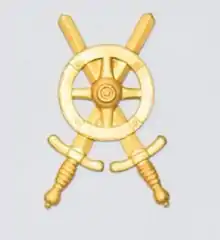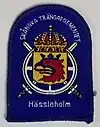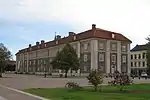| Scanian Logistic Battalion | |
|---|---|
| Skånska trängbataljonen | |
 | |
| Active | 1894–1994 |
| Country | |
| Allegiance | Swedish Armed Forces |
| Branch | Swedish Army |
| Type | Service Troops |
| Size | Battalion |
| Part of | 3rd Army Division (1894–1895) 1st Army Division (1895–1901) 1st Army Division (1902–1927) Southern Army Division (1928–1936) 1st Army Division (1937–1942) I Military District (1942–1966) Southern Military District (1966–1991) Scanian Dragoon Regiment (1991–1994) |
| Garrison/HQ | Hässleholm |
| March | "Skånska trängbataljonens marsch" (Bogren)[note 1] |
| Insignia | |
| Branch insignia |  |
| Shoulder sleeve insignia |  |
The Scanian Logistic Battalion (Swedish: Skånska trängbataljonen, T 4) was a Swedish Army logistic unit operating between 1894 and 1994. The unit was based in Hässleholm.
History
The unit traces its origins to Wendes Logistic Battalion, which was raised in 1894 at Göta Logistic Battalion and which was initially located in Karlsborg.[2] In May 1895, the battalion moved to Landskrona (Wendes Artillery Regiment's barracks). In 1901, the battalion's name was changed to Wendes Logistic Corps and in 1904 to Scanian Logistic Corps. In 1902, the 2nd Göta Logistic Corps was raised were the battalion was based. In October 1907, the corps moved to newly built barracks in Hässleholm.[2] In the 1910s, the corps had two logistic and a medical company as well as a volunteer force of 68 men (with trumpeters).[3] On 1 July 1949, the corps was changed to a regiment and in connection with this, part of the 1st Quartermaster Company (Förste intendenturkompaniet, Int 1) and the 1st Ordnance Company (Första tygkompaniet, Tyg 1) were amalgamated into the new regiment. Companies from the regiment have been stationed in Kristianstad and Revingehed. The regiment receives its conscripts mainly from Scania, Blekinge, Småland and Öland.[2]
Locations and training areas
Barracks
When the unit was formed in 1894, it was from 9 October 1894 grouped with the Göta Logistic Battalion in Karlsborg. On 9 May 1895, the unit was relocated to Landskrona, where the staff was located in Wendes Artillery Regiment's former barracks on Slottsgatan. On 3 October 1907, a relocation to a newly built barracks area at Finjagatan in Hässleholm began. On 17 October 1907, the entire unit had left Landskrona for Hässleholm. In 1943, three new barracks were built in Hässleholm and in 1958 two more barracks were built. On 1 July 1985, a move was started from Finjagatan to Garnisonsvägen, to be co-located with Scanian Dragoon Regiment. The relocation was initiated by the staff, and the relocation to Garnisonsvägen was fully completed on 1 July 1986.[4]
 Barracks, Landskrona
Barracks, Landskrona Chancery building, Hässleholm
Chancery building, Hässleholm Hospital, Hässleholm
Hospital, Hässleholm Barracks, Hässleholm
Barracks, Hässleholm Aerial view, Hässleholm
Aerial view, Hässleholm Barracks, Hässleholm
Barracks, Hässleholm Barracks, Hässleholm
Barracks, Hässleholm
Detachment
Between 1946 and 1958, the unit had four detachments:[4]
Delary
T 4 D was formed on 1 January 1946 and was a mobilization center in Delary. The center was disbanded on 31 March 1957, and transformed into a storage location for T 4.
Kristianstad
T 4 K was formed on 1 October 1947, and was a medical company from T 4, which was located in Kristianstad, for the purpose of training combat medics from the infantry. The detachment was disbanded on 31 October 1956.
Revingehed
T 4 R was formed on 1 October 1949, and was two medical companies from T 4, which were located in Revingehed due to lack of space in Hässleholm. The medical companies trained combat medics in the infantry. The detachment was disbanded on 31 January 1958.
Vetlanda
T 4 V was formed on 1 January 1946 and was a mobilization center in Vetlanda. The center was disbanded on 31 March 1957, and converted into a storage location for T 4.
Heraldry and traditions
Coat of arms
The coat of the arms of the unit was used from 1977 to 1994. Blazon: "Or, the provincial badge of Scania, an erazed head of a griffin gules, with open crown and arms azure. The shield surmounted a cart wheel of four spokes and beneath two swords in saltire, argent".[5]
Colours, standards and guidons
The regiment's colour was established by General Order No. 1228/1935. The cloth is light blue and shows in the middle the lesser coat of arms of Sweden surrounded by white rays and tongues. In the upper inner corner is affixed the head of a griffin in the provincial badge of Scania, red and crowned with a yellow open crown.[2]
 Colour
Colour
Medals
In 1994, the Skånska trängbataljonens (T 4) förtjänstmedalj i silver ("Scanian Logistic Battalion (T 4) Medal of Merit") in silver (SkåntrbatSM) of the 8th size was established. In 1997, this medal became the Skånska trängbataljonens (T 4) minnesmedalj ("Scanian Logistic Battalion (T 4) Commemorative Medal") in bronze (SkåntrbatMSM) of the 8th size. The medal ribbon is of white moiréwith broad blue edges and a red line on the middle.[6]
 Commemorative medal
Commemorative medal Commemorative medal
Commemorative medal
Commanding officers
- 1894–1907: Colonel Ivar Virgin
- 1907–1915: Colonel Georg von Heideman
- 1915–1917: Major Knut Palm
- 1917–1925: Lieutenant Colonel Carl Möller
- 1925–1933: Lieutenant Colonel Adolf Johnsson
- 1933–1942: Colonel Julius Nordlindh
- 1942–1949: Colonel Knut Hagberg
- 1949–1952: Colonel Adolf Norberg
- 1952–1955: Colonel Per Kellin
- 1955–1960: Colonel Birger Hasselrot
- 1960–1971: Colonel Folke Nordström
- 1971–1977: Colonel Nils-Olof Lindner
- 1977–1983: Colonel Rune Morell
- 1983–1988: Colonel Göran Wetterlundh
- 1988–1991: Colonel Bengt Yman
- 1991–1992: Lieutenant Colonel Torsten Hansén
- 1992–1994: Lieutenant Colonel Nils-Olof Johansson
Names, designations and locations
Note: The word träng ("train") as in trängregemente is translated to either "train", "service force"; "transport"; "baggage"; "supply vehicles" pl.; (Br) "army service corps", (US) "maintenance and supply troops",[7] "transportation" (adj.),[8] or "logistic".[9]
| Name | Translation | From | To | |
|---|---|---|---|---|
| Kungl. Wendes trängbataljon | Royal Wendes Logistic Battalion | 1894-10-01 | – | 1901-12-31 |
| Kungl. Wendes trängkår | Royal Wendes Logistic Corps | 1902-01-01 | – | 1904-12-07 |
| Kungl. Skånska trängkåren | Royal Scanian Logistic Corps | 1904-12-08 | – | 1949-06-30 |
| Kungl. Skånska trängregementet | Royal Scanian Logistic Regiment | 1949-07-01 | – | 1974-12-31 |
| Skånska trängregementet | Scanian Logistic Regiment | 1975-01-01 | – | 1991-06-30 |
| Skånska trängbataljonen | Scanian Logistic Battalion | 1991-07-01 | – | 1994-06-30 |
| Designation | From | To | ||
| No 4 | 1894-10-01 | – | 1914-09-30 | |
| T 4 | 1914-10-01 | – | 1991-06-30 | |
| P 2/T 4 | 1991-07-01 | – | 1994-06-30 | |
| Location | From | To | ||
| Karlsborg Garrison | 1894-09-10 | – | 1895-05-08 | |
| Landskrona Garrison | 1895-05-09 | – | 1907-10-17 | |
| Hässleholm Garrison | 1907-10-03 | – | 1994-06-30 |
See also
Footnotes
References
Notes
- ↑ Sandberg 2007, p. 20
- 1 2 3 4 National Archives of Sweden 1998
- ↑ Westrin 1917, p. 1330
- 1 2 Holmberg 1993, p. 43
- ↑ Braunstein 2006, p. 37
- ↑ Braunstein 2007, p. 97
- ↑ Gullberg 1977, p. 1040.
- ↑ Appich 1988, p. 167
- ↑ Grafisk profil 2013, p. 64
- Braunstein, Christian (2003). Sveriges arméförband under 1900-talet. Skrift / Statens försvarshistoriska museer, 1101-7023 ; 5 (in Swedish). Stockholm: Statens försvarshistoriska museer. ISBN 9197158445. SELIBR 8902928.
- Braunstein, Christian (2006). Heraldiska vapen inom det svenska försvaret [Heraldry of the Swedish Armed Forces] (PDF). Skrift / Statens försvarshistoriska museer, 1101-7023 ; 9 (in Swedish). Stockholm: Statens försvarshistoriska museer. ISBN 91-971584-9-6. SELIBR 10099224. Archived from the original (PDF) on 21 October 2021.
- Braunstein, Christian (2007). Utmärkelsetecken på militära uniformer [Decorations on Swedish military uniforms] (PDF). Skrift / Statens försvarshistoriska museer, 1101-7023 ; 12 (in Swedish). Stockholm: Statens försvarshistoriska museer. ISBN 978-91-976220-2-8. SELIBR 10423295. Archived from the original (PDF) on 21 October 2021.
- Gullberg, Ingvar E. (1977). Svensk-engelsk fackordbok för näringsliv, förvaltning, undervisning och forskning [A Swedish-English dictionary of technical terms used in business, industry, administration, education and research] (in Swedish) (2nd ed.). Stockholm: Norstedt. ISBN 91-1-775052-0. SELIBR 8345587.
- Holmberg, Björn (1993). Arméns regementen, skolor och staber: [en uppslagsbok] : en sammanställning (in Swedish). Arvidsjaur: Svenskt militärhistoriskt bibliotek (SMB). ISBN 91-972209-0-6. SELIBR 7796532.
- Sandberg, Bo (2007). Försvarets marscher och signaler förr och nu: marscher antagna av svenska militära förband, skolor och staber samt igenkännings-, tjänstgörings- och exercissignaler (in Swedish) (New ed.). Stockholm: Militärmusiksamfundet med Svenskt marscharkiv. ISBN 978-91-631-8699-8. SELIBR 10413065.
- Westrin, Theodor, ed. (1917). Nordisk familjebok: konversationslexikon och realencyklopedi (in Swedish). Vol. 25 (New, rev. and rich ill. ed.). Stockholm: Nordisk familjeboks förl. SELIBR 8072220.
Web
- Appich, Thomas W. Jr. (22 July 1988). "Reference Aid Swedish–English Glossary of Military and Technical Acronyms and Abbreviations" (PDF). Joint Publications Research Service. Foreign Broadcast Information Service. Archived (PDF) from the original on 20 February 2017. Retrieved 30 October 2018.
{{cite web}}: CS1 maint: ref duplicates default (link) - "Försvarsmaktens gemensamma identitet – direktiv för användandet av Försvarsmaktens namn, profil och bild" (PDF). 1.3 (in Swedish). Swedish Armed Forces. 16 September 2013. Retrieved 18 December 2020.
- "Skånska trängregementet" [Scanian Logistic Regiment] (in Swedish). National Archives of Sweden. 3 April 1998. Retrieved 23 June 2021.
Further reading
- Peterson, Arne, ed. (1993). T4 1894-1994: [100 år] : [en minnesbok] (in Swedish). Hässleholm: Skånska trängbataljonens jubileumskomm. ISBN 9163020920. SELIBR 7449668.
- Kungliga Skånska trängregementet (in Swedish). Hässleholm. 1952. SELIBR 3229701.
{{cite book}}: CS1 maint: location missing publisher (link) - Två jubilarer 80+40=120 år: grattis T4 och P2. Norra Skåne, 4112752 ; 1987:2 (in Swedish). Hässleholm. 1987. SELIBR 8869137.
{{cite book}}: CS1 maint: location missing publisher (link) - Larsson, Ingar (1957). Historik över musikkårens vid T 4 verksamhet (in Swedish). Hässleholm. SELIBR 8870281.
{{cite book}}: CS1 maint: location missing publisher (link) - Skånska Trängregementet: T4 : Hässleholm (in Swedish). Hässleholm. 1985. SELIBR 8870286.
{{cite book}}: CS1 maint: location missing publisher (link)